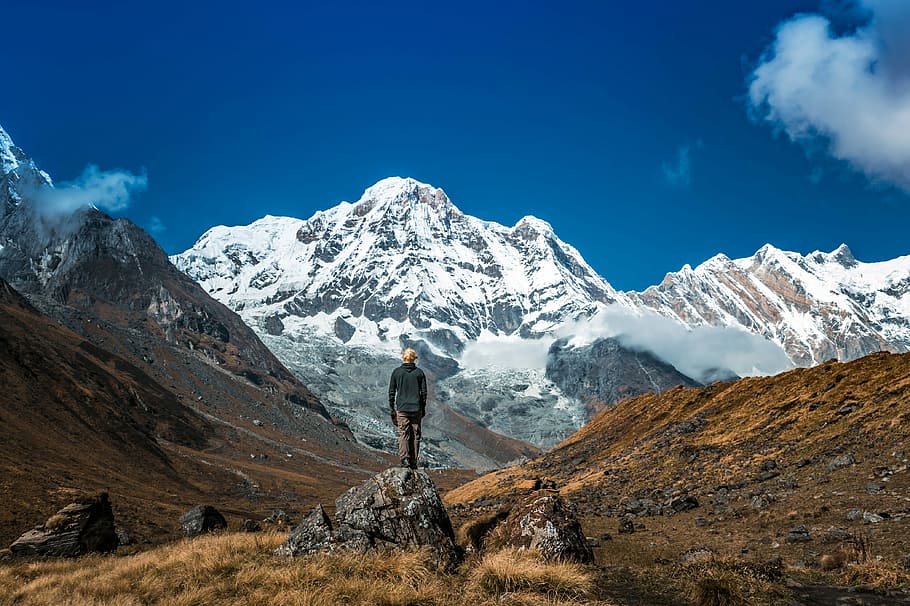
Trekking to Annapurna Base Camp: A Journey into the Heart of the Himalayas
Introduction:
Nepal, often referred to as the “Land of the Himalayas,” is a paradise for adventure enthusiasts and nature lovers. One of the most iconic trekking destinations in Nepal is the Annapurna Base Camp (ABC). Nestled in the heart of the Annapurna Massif, this trek offers a mesmerizing blend of natural beauty, diverse landscapes, and a rich cultural experience. Annapurna Base Camp Trek is a bucket-list adventure for many, and in this article, we will explore why.
The Journey Begins: Pokhara to Nayapul
The journey to Annapurna Base Camp typically begins in the picturesque city of Pokhara, which is easily accessible by road or air from Kathmandu, the capital of Nepal. Pokhara, with its serene lakes and stunning mountain views, serves as the perfect gateway to the Annapurna region.
From Pokhara, trekkers make their way to Nayapul, the starting point of the ABC trek. The drive to Nayapul offers a glimpse of rural life in Nepal as you pass through quaint villages and terraced fields. Once you arrive in Nayapul, it’s time to lace up your hiking boots and begin your adventure.
The Trekking Experience: Nature’s Bounty
The Annapurna Base Camp trek is renowned for its diverse landscapes. The trail meanders through lush rhododendron forests, terraced fields, and charming villages inhabited by various ethnic groups, such as the Gurungs and Magars. Along the way, you’ll have the opportunity to interact with friendly locals, learn about their culture, and savor traditional Nepali cuisine.
As you ascend, the scenery undergoes a dramatic transformation. The snow-capped peaks of the Annapurna and Machapuchare (Fishtail) mountains gradually come into view. The Machapuchare, in particular, with its distinctive fishtail shape, is a sight to behold.
The journey is not without its challenges, as you’ll encounter steep ascents and descents, suspension bridges swaying over rushing rivers, and rocky terrain. However, the rewards are well worth the effort. Every step brings you closer to the breathtaking vistas that await at Annapurna Base Camp.
Annapurna Sanctuary: A Natural Amphitheater
The final destination of the trek, Annapurna Base Camp, is nestled in a natural amphitheater surrounded by some of the world’s highest peaks. At an altitude of approximately 4,130 meters (13,549 feet), this pristine sanctuary offers a 360-degree panorama of towering giants, including Annapurna I (8,091 meters/26,545 feet) and Annapurna South (7,219 meters/23,684 feet).
The sense of accomplishment and awe that washes over trekkers as they stand in this breathtaking amphitheater is indescribable. The sunrise and sunset views from Annapurna Base Camp are especially enchanting, casting a warm, golden glow on the snow-capped peaks and filling the heart with tranquility.
Cultural Encounters Along the Way
While the natural beauty of the Annapurna region is undoubtedly the main attraction, the cultural experiences you encounter during the trek are equally enriching. The villages along the trail are home to warm and hospitable communities. You’ll have the chance to visit local teahouses and lodges, where you can rest, refuel, and immerse yourself in the local culture.
The Gurung and Magar communities are known for their rich traditions, including vibrant festivals, lively dances, and intricate handicrafts. Engaging with these communities provides a deeper understanding of the people who call this rugged terrain their home.
Trekking Seasons: When to Go
The best time to embark on the Annapurna Base Camp trek depends on your preferences and tolerance for weather conditions. The two primary trekking seasons are autumn (September to November) and spring (March to May).
Autumn: This is the most popular time for trekking to Annapurna Base Camp. The weather is stable, with clear skies and comfortable temperatures. The trails are adorned with blooming rhododendrons, adding a splash of color to the landscape.
Spring: Spring is another excellent season for the trek. The weather is mild, and the valleys come alive with lush greenery and a variety of wildflowers. However, be prepared for occasional rain showers.
Winter (December to February) and monsoon season (June to August) are less favored times for trekking due to cold temperatures and heavy rainfall, respectively.
Trekking Essentials and Preparation
Before embarking on the Annapurna Base Camp trek, there are several essential considerations:
-
Permits: Trekkers need to obtain the Annapurna Conservation Area Permit (ACAP) and Trekkers’ Information Management System (TIMS) card, which can be arranged through a registered trekking agency.
-
Physical Fitness: While the trek is suitable for most people with moderate fitness levels, it’s essential to prepare physically by incorporating cardiovascular and strength exercises into your routine.
-
Gear: Invest in high-quality trekking gear, including a good pair of hiking boots, warm clothing, a reliable backpack, and a sleeping bag suitable for cold weather.
-
Altitude Acclimatization: Ascending slowly is crucial to avoid altitude sickness. Plan your itinerary to include acclimatization days and stay hydrated.
-
Guide and Porter: Hiring a local guide and porter is highly recommended. They provide valuable insight, assist with navigation, and lighten your load, allowing you to fully enjoy the trek.
Conclusion: A Trek of a Lifetime
Trekking to Annapurna Base Camp is a journey that offers much more than just stunning vistas. It’s an opportunity to connect with nature, immerse yourself in diverse cultures, and challenge your physical and mental limits. This trek is not just a trip; it’s an unforgettable adventure that leaves an indelible mark on your soul.
As you stand at the heart of the Annapurna Sanctuary, surrounded by towering peaks and the serenity of the Himalayas, you’ll realize that this trek is not just about reaching the destination but about embracing the entire journey—the beauty, the culture, and the people. Annapurna Base Camp is an experience that will stay with you long after you’ve left the mountains behind, a testament to the enduring allure of the Himalayas.



